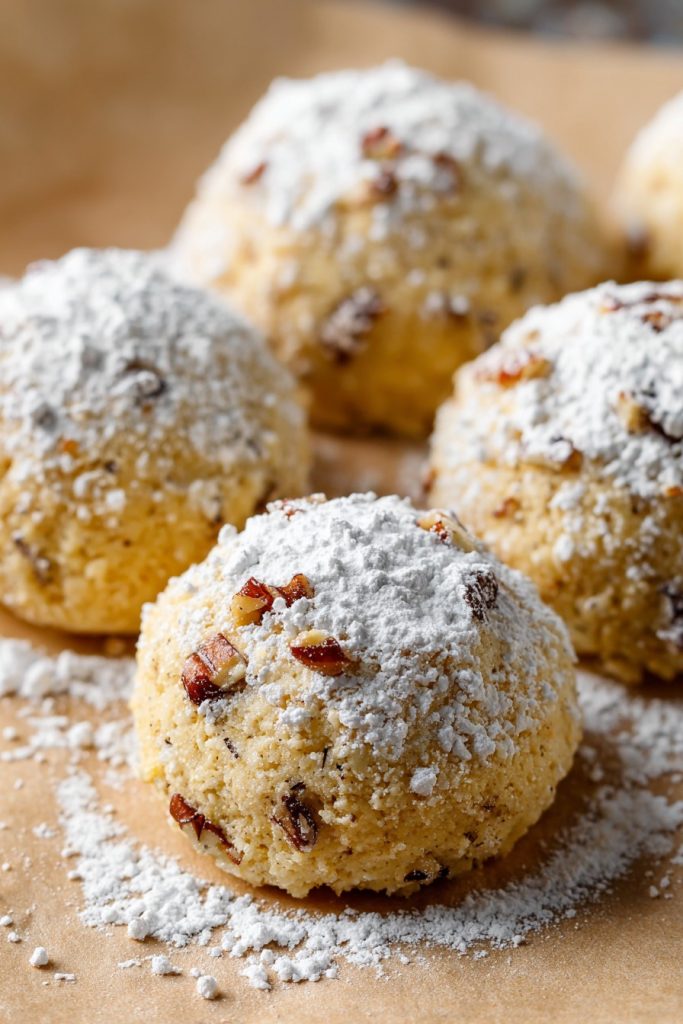Understated yet unforgettable, butter balls deliver pure buttery bliss in bite-sized form. Using just a handful of pantry staples, these cookies require no special skills or equipment. Their delicate texture and rich flavor make them perfect for holiday baking or everyday treats.
Why This Recipe Works
- The high butter-to-flour ratio creates an exceptionally tender, melt-in-your-mouth texture that dissolves on the tongue without being overly crumbly or dry.
- Using finely chopped pecans adds subtle nutty flavor and textural contrast while helping bind the dough without making it heavy or dense.
- Chilling the dough before shaping ensures the butter firms up properly, preventing spreading during baking and maintaining the perfect spherical shape.
- Double coating in powdered sugar creates that signature snowy appearance and provides the ideal sweet contrast to the rich, buttery cookie base.
- The simple ingredient list means you can whip these up with pantry staples, and the straightforward technique makes them accessible for bakers of all skill levels.
Ingredients
- 1 cup unsalted butter, softened to room temperature
- 1/2 cup granulated sugar
- 2 teaspoons vanilla extract
- 2 cups all-purpose flour, spooned and leveled
- 1 cup pecans, finely chopped
- 1/4 teaspoon salt
- 1 cup powdered sugar for coating
Equipment Needed
- Stand mixer or hand mixer
- Mixing bowls
- Measuring cups and spoons
- Baking sheets
- Parchment paper or silicone baking mats
- Wire cooling rack
- Small bowl for powdered sugar coating
Instructions

Cream the Butter and Sugar
Place 1 cup of softened unsalted butter and 1/2 cup granulated sugar in the bowl of a stand mixer fitted with the paddle attachment. Beat on medium speed for 2-3 minutes until the mixture becomes pale, fluffy, and well-combined. The butter should lighten in color significantly and the sugar should be fully incorporated without any graininess remaining. Scrape down the sides of the bowl with a spatula to ensure even mixing. Add 2 teaspoons of vanilla extract and mix for another 30 seconds until fully incorporated. The creaming process is crucial for creating air pockets that will give the cookies their light texture, so don’t rush this step. Properly creamed butter and sugar should hold peaks when you lift the paddle attachment.
Combine Dry Ingredients
Chill the Dough
Transfer the cookie dough to a clean bowl and cover tightly with plastic wrap, pressing the wrap directly onto the surface of the dough to prevent it from drying out. Refrigerate for at least 1 hour, or up to 24 hours if preparing ahead. The chilling time is non-negotiable for achieving the proper texture – cold butter melts more slowly in the oven, preventing excessive spreading and maintaining the spherical shape. If you skip this step, your butter balls will likely flatten into puddles rather than holding their form. The dough should be firm enough to handle without sticking to your hands, but not so hard that it cracks when you try to shape it. If it becomes too firm, let it sit at room temperature for 10-15 minutes before proceeding.
Shape and Bake
Preheat your oven to 325°F and line baking sheets with parchment paper or silicone baking mats. Using a tablespoon or small cookie scoop, portion the chilled dough into 1-inch balls, rolling them between your palms to create smooth spheres. Place the balls about 2 inches apart on the prepared baking sheets to allow for slight spreading. Bake for 15-18 minutes, rotating the pans halfway through baking, until the bottoms are lightly golden and the tops look set but still pale. The cookies should not brown on top – if they start to color, they’re overbaked. They will feel soft when you remove them from the oven but will firm up as they cool. For even baking, bake one sheet at a time in the center rack position.
Coat with Powdered Sugar
Let the baked cookies cool on the baking sheet for 5 minutes until they’re firm enough to handle but still warm. Place 1 cup of powdered sugar in a shallow bowl. Working with a few cookies at a time, gently roll each warm cookie in the powdered sugar until completely coated. Transfer the sugared cookies to a wire rack to cool completely. Once completely cool, roll each cookie in powdered sugar a second time to create that classic snowy appearance. The first coating while warm helps the sugar adhere better, while the second coating creates the finished look. If the powdered sugar starts to clump, sift it before continuing. Store the finished butter balls in an airtight container at room temperature.
Tips and Tricks
For the best texture, ensure your butter is properly softened – it should yield to gentle pressure but still hold its shape. To quickly soften cold butter, cut it into tablespoon-sized pieces and let it sit at room temperature for 20-30 minutes. Don’t microwave it, as melted butter will change the cookie’s texture dramatically. When measuring flour, use the spoon-and-level method rather than scooping directly from the bag, which can pack in too much flour and make dry cookies. Spoon flour into your measuring cup until heaping, then level off with a straight edge.
If you prefer different nuts, walnuts work equally well as pecans, or you can use almonds for a slightly different flavor profile. Toast the nuts before chopping for deeper flavor – spread them on a baking sheet and toast at 350°F for 8-10 minutes until fragrant. Let them cool completely before chopping and adding to the dough. For those with nut allergies, you can substitute the pecans with an additional 1/4 cup of flour and 1/4 cup of rolled oats pulsed in a food processor until finely ground.
The dough can be made up to 3 days in advance and stored tightly wrapped in the refrigerator, or frozen for up to 3 months. To freeze, portion the dough into balls before chilling, then transfer the unbaked balls to a freezer bag. When ready to bake, arrange frozen balls on baking sheets and add 1-2 minutes to the baking time. This makes butter balls perfect for holiday baking prep or last-minute guests. If your kitchen is particularly warm, chill the shaped balls for 15 minutes before baking to prevent spreading.
For perfectly round cookies, roll the dough between your palms using even, gentle pressure. If the dough starts sticking to your hands, chill it for another 15 minutes or lightly dust your hands with flour. Don’t use powdered sugar on your hands while shaping, as it will burn during baking. If your cookies develop small cracks during baking, they’ll be covered by the powdered sugar coating, so don’t worry about perfection. Store finished cookies between layers of parchment paper in an airtight container to prevent them from sticking together.
Recipe Variations
- Chocolate-dipped butter balls: Melt 8 ounces of semi-sweet chocolate with 1 tablespoon of coconut oil. Dip half of each cooled cookie in chocolate, let excess drip off, then place on parchment-lined baking sheet. Refrigerate until set.
- Lemon or orange variation: Replace vanilla extract with 2 teaspoons of lemon or orange extract, and add 1 tablespoon of finely grated citrus zest to the dough. The bright citrus flavor cuts through the richness beautifully.
- Spiced butter balls: Add 1 teaspoon of cinnamon, 1/4 teaspoon of nutmeg, and 1/8 teaspoon of cloves to the flour mixture. For the coating, mix powdered sugar with 1/2 teaspoon of cinnamon.
- Coconut butter balls: Replace 1/2 cup of the flour with 1/2 cup of finely shredded unsweetened coconut. Roll the finished cookies in a mixture of powdered sugar and additional shredded coconut.
- Maple pecan version: Replace granulated sugar with 1/2 cup of maple sugar, and add 1 teaspoon of maple extract along with the vanilla. The deeper flavor pairs wonderfully with the pecans.
Frequently Asked Questions
Can I make butter balls without nuts?
Yes, you can omit the pecans entirely and increase the flour by 1/4 cup to maintain the proper dough consistency. The cookies will have a slightly different texture – more shortbread-like and less complex in flavor, but still delicious. Alternatively, you could substitute with an equal amount of toasted coconut flakes, crushed pretzels for a sweet-salty version, or even finely crushed cornflakes for added crunch. Without nuts, the cookies may spread slightly more during baking, so ensure your dough is thoroughly chilled before shaping and baking.
Why did my butter balls spread too much?
Excessive spreading usually results from insufficiently chilled dough, butter that was too soft or partially melted, or an oven that wasn’t properly preheated. The dough must be chilled for at least 1 hour to firm up the butter, which prevents spreading during baking. Also check your oven temperature with an oven thermometer – if it’s running cool, the butter will melt before the structure sets. Using parchment paper or silicone mats rather than greased baking sheets also helps control spreading. If your kitchen is warm, consider chilling the shaped balls for 15 minutes before baking.
Can I freeze butter balls?
Butter balls freeze exceptionally well both before and after baking. For unbaked dough, portion into balls and freeze on a baking sheet until solid, then transfer to freezer bags for up to 3 months. Bake directly from frozen, adding 1-2 minutes to the baking time. Already baked cookies can be frozen without the final powdered sugar coating – freeze them on a baking sheet, then store in airtight containers. Thaw at room temperature, then apply the powdered sugar coating. The texture remains perfect after freezing, making these ideal for make-ahead holiday baking.
How long do butter balls stay fresh?
Properly stored in an airtight container at room temperature, butter balls maintain their texture and flavor for up to 2 weeks. The powdered sugar coating may gradually be absorbed into the cookies, making them appear less snowy after several days. If this happens, you can re-roll them in additional powdered sugar before serving. Avoid refrigeration, as the moisture can make the cookies soggy and cause the sugar coating to dissolve. For longer storage, freezing is recommended. If your cookies become slightly stale, you can refresh them by warming in a 300°F oven for 3-5 minutes, then re-coating with powdered sugar.
Can I use salted butter instead of unsalted?
You can use salted butter, but omit the additional 1/4 teaspoon of salt from the recipe. Different brands of salted butter contain varying amounts of salt, so using unsalted butter gives you better control over the final flavor. If you only have salted butter available, taste the dough before baking and adjust if needed. The small amount of salt enhances the buttery flavor without making the cookies taste salty, so don’t skip it entirely unless dietary restrictions require it. The salt also helps balance the sweetness of the powdered sugar coating.
Summary
Butter balls deliver maximum flavor with minimal effort. The simple technique of creaming butter and sugar, chilling the dough, and double-coating in powdered sugar creates cookies that melt in your mouth. Perfect for holidays or everyday treats, they store well and adapt easily to variations.
Butter Balls
6
servings20
minutes18
minutesIngredients
Instructions
- 1 Cream butter and granulated sugar until light and fluffy, about 3 minutes. Add vanilla and mix until combined.
- 2 Whisk flour and salt together, stir in chopped pecans. Gradually add to butter mixture until dough forms.
- 3 Cover and chill dough for at least 1 hour until firm.
- 4 Preheat oven to 325°F. Roll dough into 1-inch balls and place 2 inches apart on parchment-lined baking sheets.
- 5 Bake for 15-18 minutes until bottoms are lightly golden. Cool 5 minutes on baking sheets.
- 6 Roll warm cookies in powdered sugar, cool completely, then roll in powdered sugar again.



